AMD Raven Ridge Thermal/Power Analysis: Ryzen CPUs With Vega
CPU & GPU Stress Testing: Benchmarks & Results
CPU Stress Test: Prime95 Small FFTs
Prime95 is to CPUs what FurMark is for GPUs: a true classic, updated over the years with support for new instructions. Current versions support AVX extensions, which they use to generate massive thermal loads. Running such an intensive task pushes many platforms over the edge. That's why some enthusiasts are forced to set AVX offsets in their BIOSes. Often, that's the only way to stabilize an aggressive overclock.
We’re using the most extreme settings to determine how far AMD's Zen cores will go with no load on the graphics subsystem.
AMD Ryzen 3 2200G
At a reading in excess of 80°C, the stock cooler is pushing as hard as possible. As expected, we observe a massive power consumption increase: the average is 54W, while the peaks hit 67W. This gets us close to AMD's TDP rating. But there's still a little room left...

The graphics unit idles along at 220 MHz, while the Zen cores operate at a fairly consistent ~3.65 GHz.
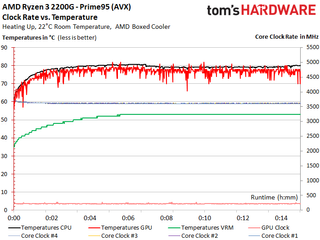
AMD Ryzen 5 2400G
The stock cooler faces a real challenge now, but manages to keep Ryzen 5 2400G at 85°C. Its efforts are much more audible by this point, too.
Stay on the Cutting Edge
Join the experts who read Tom's Hardware for the inside track on enthusiast PC tech news — and have for over 25 years. We'll send breaking news and in-depth reviews of CPUs, GPUs, AI, maker hardware and more straight to your inbox.
The 15-minute run’s average of 76W and peaks as high as 83W exceed AMD's 65W TDP by a large margin. However, it’s not like AVX-optimized applications make an everyday appearance on platforms powered by sub-$200 processors.
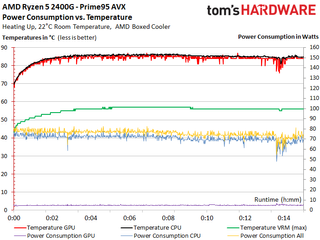
The CPU’s clock rate drops a little as the temperature rises. However, the difference between our initial 3.75 GHz measurement and the later 3.7 GHz reading is barely noticeable.

GPU Stress Test: MSI Kombustor Core Burner
MSI’s Kombustor applies a taxing load to the graphics engine exclusively, giving us plenty of options for configuring various tests. The rule of thumb is to choose a resolution that’s just high enough for smooth frame rates without stuttering.
There’s a reason why we cut our run's length from 15 to 7.5 minutes: we observed a mysterious phenomenon using the Ryzen 5 2400G, which started at ~4 minutes into the test. We'll go into more detail below. Don't worry, though: the processor does warm up completely within this time frame.
AMD Ryzen 3 2200G
The 512-shader Ryzen 3 2200G consumes an average of ~38W in this benchmark, which is less than we expected. A maximum GPU temperature of 51°C and a voltage converter ceiling of 56°C aren't bad, either.
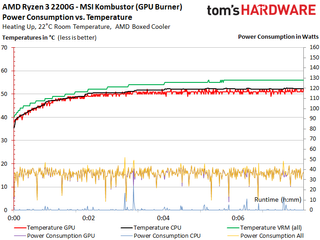
In spite of the debilitating load, AMD's graphics engine maintains its 1100 MHz clock rate. That's incredibly impressive for integrated graphics during such a taxing benchmark.
The CPU’s occasional spikes are lost among general noise, and the Zen cores operate at a fairly consistent clock rate.

AMD Ryzen 5 2400G
So, about that mysterious phenomenon we mentioned earlier: it involves inexplicable clock rate measurements. We asked AMD for guidance, and its representatives couldn't come up with an answer. Next, we asked MSI to validate what we found on Gigabyte's board, and it reliably replicated our results using an MSI motherboard. So, what we observed is neither a fluke nor an isolated incident.
For one reason or another, the 2400G throttles while its total power consumption is at a rather moderate average of 44W. The spiky behavior only starts after the throttling-like phenomenon kicks in. This is most definitely not due to thermal limits either, since an average temperature of 52°C and a ~60°C peak aren't problematic readings.
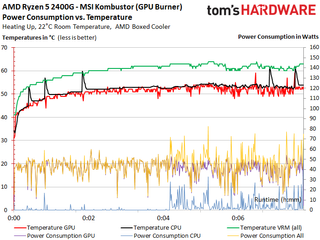
The phenomenon is evident in extreme GPU frequency oscillations as well, providing further evidence of something strange going on. There’s no reason for these spikes and dips: no unexpected CPU load is applied and no other applications are running.
What makes this worse is that the throttling doesn't stop, even after the stress test ends and the system idles for a prolonged period of time. The only way to get back to normal frequencies is rebooting the system.
For what it's worth, the issue we're describing only appears to affect Ryzen 5 2400G. But it can be triggered on every sample we've seen.
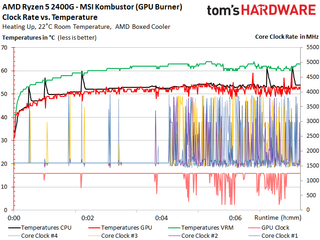
The distribution of peak loads between the CPU and GPU blocks works well, even though AMD's Ryzen 5 2400G demonstrated strange and unexpected behaviors that we cannot explain. The throttling we observed didn’t occur when running games or normal applications, but was reproducible during the GPU stress test, several GPGPU applications, and GPU-accelerated render/encode benchmarks in our suite.
MORE: Best CPUs
MORE: Intel & AMD Processor Hierarchy
MORE: All CPUs Content
Current page: CPU & GPU Stress Testing: Benchmarks & Results
Prev Page Gaming: Benchmarks & Results Next Page Combined Stress Testing: Benchmarks & Results-
Combat_Medic The prices you chose to use here are bogus - the $99 and $169 MSRP are what they're actually going for.Reply -
AgentLozen ReplyCombat_Medic said:The prices you chose to use here are bogus - the $99 and $169 MSRP are what they're actually going for.
The prices from Amazon or NewEgg (or whatever) are usually inaccurate. I think Tom's should provide us with the MSRP and the internet price. That way, if the internet price is malfunctioning and showing a +50% markup, at least we know what it's SUPPOSED to sell for.
edit: minor fix -
FormatC When I wrote this review, we had only the official MSRP from AMD. The availability in Germany looks ok and the prices in EUR with VAT are lower :)Reply -
Ninjawithagun The prices (provided via direct link to Amazon.com) are now correct. Unfortunately, they are all sold out...lol.Reply -
JamesSneed These seem to be very efficient for the CPU and GPU performance they deliver. Nifty more options for budget PC's.Reply
I am left wondering if the 14nm process AMD is using, is having issues scaling to higher frequencies as it appears you keep Zen and Vega at lower clocks and they are very efficient. -
FormatC I really like the new power management and it is finally nothing else as efficiency-orientated mobile technology for the desktop.Reply -
nuclearpowerofattorney Maybe the 2400G is so smart and powerful, that when it reaches critical computational capacity, it evolves to become sentient, and thus unruly. Only after it is rebooted, to have the sentience removed, will the system cease its rebellious behavior. (Actually, I don't think this..but it's all I've got).Reply -
Rookie_MIB For the 2400G, bundling the better Wraith Spire could probably avoid the throttling bouncing around by preventing it from hitting the thermal limits under the more taxing loads.Reply
Eventually though they're going to have to find out what's causing it to get stuck in that loop. -
7angrytangerines Obviously 2400G wants to protect itself from some poor saps trying to use it for cryptocurrency mining.Reply
Most Popular





